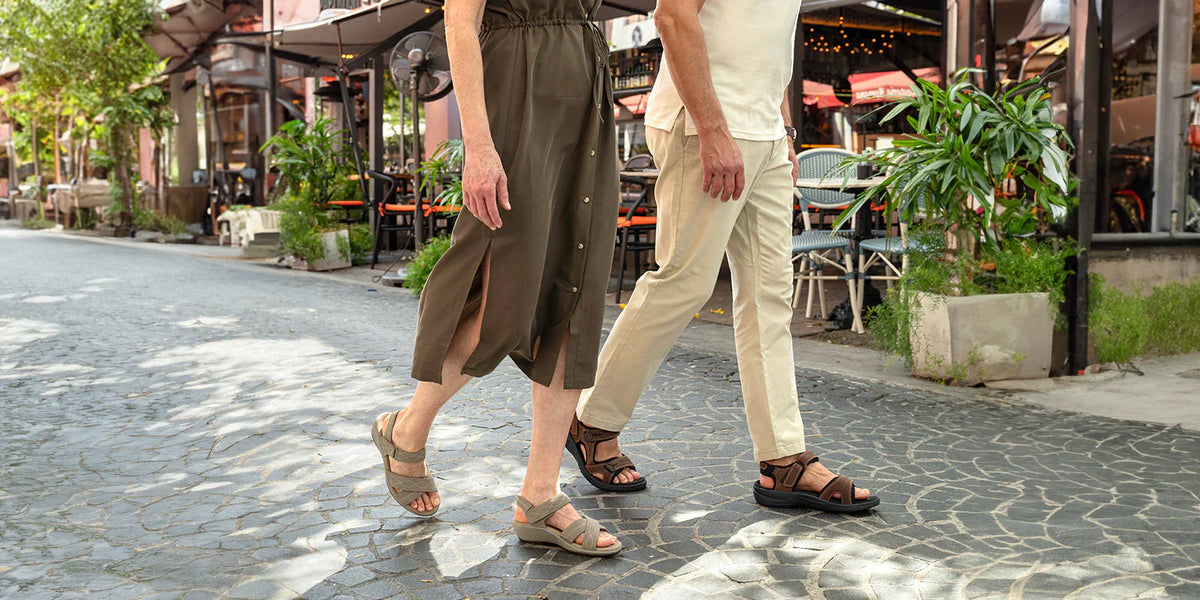The Orthofeet Blog
- All Posts
- All
- Arch Support
- Back Pain
- Bunion
- Diabetes
- Flat Feet
- Foot Pain
- Heel Pain
- Heel Spurs
- Hip Pain
- Knee Pain
- Plantar Fasciitis
- Swollen Feet

Vincent Lin / October 21, 2025
Can Stress Cause Burning Feet? Understanding the Connection
Can Stress Cause Burning Feet? Understanding the Connection
Read Post
Popular Articles
EXPERT CONTRIBUTORS
-
Can Plantar Fasciitis Cause Leg Pain?
Medical information provided by Orthofeet Team / June 06, 2025Plantar fasciitis is often described as "a real pain in the foot." Many patients report that this condition significantly disrupts their daily activities, making it difficult to stand, walk, run, and work. Questions like "does plantar fasciitis cause leg pain, knee pain, or ankle pain?" are common, as the sharp and severe pain can radiate and affect other parts of the lower body. The impact of what might initially seem like simple foot pain can indeed be life-altering. To address these challenges, choosing the right supportive plantar fasciitis shoe can make a significant difference in managing symptoms and enhancing mobility. For those looking to manage their condition actively, incorporating plantar fasciitis exercises can be particularly beneficial. Leg pain and plantar fasciitis So, can plantar fasciitis cause leg pain? The answer is a definite YES. In addition to foot pain, there can be pain radiating up the leg. This can occur directly from nerve pain at the calcaneus branches, which can radiate back up the nerve tract in the leg, causing ankle and calf pain. Another cause of leg pain is when there is pain on the foot and in particular at the heel, people often change their stance and gait to avoid the painful area. This alters normal lower extremity mechanics, which can lead to overuse injuries or pain to the muscles and tendons in the lower leg, and sometimes in the upper leg, hip and back. Learning how to prevent plantar fasciitis can also mitigate these related issues. So, treatment for plantar fasciitis can affect more than just the foot. What is plantar fasciitis? Well, the story starts with discussing the culprit: the plantar fascia is a thick, web-like ligament on the bottom of the foot. The plantar fascia lies just under the skin and in most people it can be easily seen and felt by pulling the toes up. This causes the fascia to tighten and stick out to be easily visualized and palpated, especially in the arch area. It feels like a tight band there. Anatomically, the plantar fascia connects from the calcaneus (the heel bone) to the base of the toes, which means it stretches almost the full length of the foot. Like a ligament, it connects bone to bone, but structurally it is closer to a tendon with limited blood and nerve supply. These characteristics are part of the reason it is often slow to heal from injury. The plantar fascia is made of collagen-based connective tissue and as it stretches out in a wide band, it is properly called an Aponeurosis. Functionally, the fascia acts like a tie-rod to hold the foot together as it connects the toes to the heel. When the arch is at maximal height, the fascia is shorter as the foot is shorter. As a person stands and the arch drops, the foot lengthens and stretches, elongating and tightening the fascia. In the gait cycle when walking or running, as a person pushes off, the toes flex back, which causes the fascia to tighten and raises the arch to stabilize the foot for propulsion. This is called the windlass mechanism. Dysfunction in this action is one of the causes of plantar fasciitis, as will be discussed later in this blog. Symptoms of plantar fasciitis Plantar fasciitis is pain anywhere on the fascia, including the most common bottom of the heel pain. The most prevalent scenario is pain when first standing and then it often temporarily improves after moving around, only to get worse as there is continued activity. Often, the more time on the feet, the worse the pain. Monitoring the signs plantar fasciitis is healing can help patients manage expectations and track progress. It is not truly an inflammation as much as actual micro trauma damage to the fascia with some structural breakdown, due to being overworked or stressed. There can also be periostitis of the heel bone - inflammation of the periosteum, the coating over the bone. As the fascia connects to the periosteum, it becomes all involved and is called plantar fasciitis. In all my years of treating heel pain, this is more common than pain further up the fascia in the arch. Another type of pain in the bottom of the foot can involve neuritis or nerve pain, as the heel has several nerve branches passing along and under it. If these nerves are irritated, there can be a burning pain radiating around the heel and often pain up the leg. Often, neuritis occurs together with fasciitis, causing foot and leg pain. As we age, the fat pad on the bottom of the heel thins out, which can lead to periostitis from direct trauma to the bone or periosteum, and/or neuritis from the nerve under the heel being compressed between the bone and the floor. What causes plantar fasciitis? There are multiple causes of this syndrome. Often, in a patient there is more than one cause. Dysfunction in the windlass mechanism mentioned above is a major cause. The fascia is overworked and stretched when the mechanism malfunctions, which leads to micro tears, structural damage and pain. A major cause of the windlass mechanism malfunctioning is dysfunction of the big toe joint to the foot. If the big toe can’t flex properly, the windlass mechanism will not work correctly and this can damage the fascia. Big toe joint dysfunction can occur from actual damage to the joint from arthritis or from over pronation, where the arch flattens on stance, jamming the joint. Other causes of plantar fasciitis are weight gain, which puts physical stress on the foot. The fascia being a tie-rod stabilizing the foot will be overworked by excess weight, as it works harder to handle the increased physical force. As mentioned above, fat pad atrophy with age can also cause pain in the heel at the fascia insertion on the heel. Simple over pronation, where the arch drops, causes lengthening of the foot, which puts a stretch force on the fascia as it attempts to hold the foot together. This over works the fascia, causing micro trauma and pain. This issue can be exacerbated by poor shoes or soft worn out shoes, as pronation is often worse with soft or poor shoes. Heel spur vs. plantar fasciitis At this point, I also want to discuss heel spur syndrome, as it is often confused with plantar fasciitis, especially when you're experiencing chronic heel pain. Understanding the key differences between plantar fasciitis vs heel spurs is crucial for effective treatment. As the fascia connects to the bottom of the heel there can be fascia pain directly at the insertion point on the heel. This can also cause heel bone periostitis, as the fascia connects to the periosteum. There is often a heel spur that develops on the tubercle on the bottom of the heel bone, where the fascia inserts. The spur usually has little to do with the pain. In fact, on x-ray, the foot with no pain had a bigger spur than the painful foot. I tell my patients the spur is often more of a barometer measuring stresses on the foot, but not actually the cause of the symptoms. This means we don’t treat the spur itself and don’t need to remove it to minimize pain. How to treat plantar fasciitis Shoes and Orthotics With almost no exceptions I ALWAYS start with SHOES for plantar fasciitis treatment. We ask patients to bring in most of their shoes for their initial visit, and anytime thereafter when they experience plantar heel pain or sharp pain associated with this condition. As noted above, shoes can be a major cause of fasciitis and other foot pain. If the shoes are worn out or improper, I start treatment by having them purchase new and more appropriate shoes, such as men's plantar fasciitis shoes or plantar fasciitis shoes for women. The shoes need to fit correctly, as I often find patients wear shoes too short or too tight. This can affect the big toe joint function, which damages the fascia, as can over pronation from poor shoes. I have seen many patients improve in 2 to 3 weeks from just purchasing new, more appropriate shoes that fit well. Each patient is different, so I can’t recommend a blanket one style of shoe, but in general, A solid heel counter to control motion. Have a solid outer sole. Have some motion control features. Many patients need extra depth and width for unrestricted toe movement and a pressure free environment. Good orthopedic footwear brands biomedically design plantar fasciitis shoes that help alleviate strain on the plantar fascia. Featuring ergonomic soles, such shoes reduce impacts on the heel and provide soft, protective cushioning. Insoles and Orthotics The next step in the treatment usually involves some type of plantar fasciitis insole or orthotic. Since many patient’s main symptom is heel pain, the insert should cup and cushion the heel and support the arch. In general, a well-made insole will reduce pronation and help improve big toe joint function, while cushioning the heel. This is the starting point in my office for most of these patients. In my practice, I use non custom orthotics as my first line of treatment along with shoes. The insoles I use have a gel heel pad in the heel cup, an anatomical arch support and tends to mold to the specific shape of the foot over time. They are very comfortable from the moment they are inserted in the shoes, which patients really appreciate and will actually wear them as a result. Additional Treatments if Initial Steps Fail Another treatment option is corticosteroid (cortisone) injections, which may require two to three sessions. I typically wait until the patient has the proper shoes and inserts before administering this treatment, as the success rate is higher when used in conjunction with proper footwear. If the above treatments fail, the next step may involve the patient wearing an immobilizing boot 24 hours a day for a few weeks. The insole is also inserted in the boot to increase effectiveness. Although a night splint is not very beneficial, wearing a walking boot at night can have a powerful impact. Finally, if all other treatment options do not work, shock wave treatment may prove beneficial, or surgery as a last resort. It is important to note that surgery might improve symptoms initially but can destabilize the foot in the long run, often leading to new pain later. In summary, plantar fasciitis is very common. If you develop pain on the bottom of the foot, the sooner you seek out medical help, such as a podiatrist, the sooner you will improve. Waiting longer just causes more pain and is more complicated to treat, as well as slower.Read More -
How to Treat Plantar Fasciitis at Home
Medical information provided by Orthofeet Team / June 06, 2025If you’ve ever rolled out of bed, taken those first few steps, and felt a sharp pain in your heel or along the bottom of your foot, you likely have plantar fasciitis – a foot condition that makes mornings, and any first steps after resting, quite a struggle. Luckily, in most cases, plantar fasciitis is treatable, and various home remedies can accelerate the healing process and provide relief from plantar fasciitis pain. But before we discuss how to treat plantar fasciitis at home, here’s a quick rundown of what causes it and how it develops. The ins and outs of plantar fasciitis The plantar fascia is a thick band of tissue running from your heel to the base of your toes, connecting the heel bone to the base of your toes and supporting the arch. Understanding the tissue's role is crucial in recognizing the underlying cause of plantar fasciitis symptoms. When it gets overstretched, it tends to develop tiny tears that cause discomfort or pain. There are certain factors that can increase your risk of developing plantar fasciitis, such as: Being between 40-60 years old. Wearing shoes that have seen better days. Doing high-impact activities like running, especially without proper footwear. Having flat feet or high arches. An unusual walking pattern or foot posture. Carrying extra weight, which adds to the load your feet bear. Spending hours standing or walking, especially on hard surfaces. If any of these sound familiar, your feet might be more prone to this nagging condition. The upside is, how to treat plantar fasciitis at home is a question with plenty of answers. At-home remedies for heel pain The most common cause of heel pain is plantar fasciitis and while there are no remedies as such, there certainly are ways to alleviate plantar fasciitis heel pain at home. So, what treatment options can you explore at home to relieve plantar fasciitis symptoms? Here are some tips and tricks that will provide relief and help your feet feel better. Stretching and strengthening exercises The answer to 'how to treat plantar fasciitis at home' starts with simple routine exercises that help prevent the tiny tears in the plantar fascia by making this band stronger and more flexible. Strengthening exercises Strengthening not just your foot, but also your hip and thigh muscles, helps provide better support for your arch. This means less strain on your plantar fascia and, ultimately, less pain [1]. Try these simple but effective exercises to strengthen the plantar fascia: 1. Toe Curls Sit down with your feet resting flat on the floor. Place a small towel on the floor in front of you. Use your toes to grip the towel and pull it toward you. Repeat 10-15 times. Why it works: Strengthens the tiny muscles in your foot. Helps your arch stay supported. Reduces stress on the plantar fascia. 2. Marble Pickup Sit comfortably with your feet on the ground. Scatter 10-15 marbles on the floor and place a small container nearby. Use your toes to pick up each marble and drop it into the container. Repeat until all marbles are picked up. *Alternatively, you can use a single marble and repeat this exercise 10–15 times. Why it works: Improves toe flexibility and control. Strengthens foot muscles. Gives your arch extra support. 3. Calf raises Stand with your feet shoulder width apart, using a wall or sturdy surface for balance if needed. Slowly rise onto the balls of your feet, lifting your heels. Hold for 5–10 seconds, then gently lower your heels back down. Repeat 10–15 times. Why it works: Eases tightness in the plantar fascia. Strengthens muscles that support the arch. Improves foot stability. Stretching exercises Just like you stretch your muscles as a warm up before exercising, stretching your plantar fascia first thing in the morning can help prepare it for a day of activity ahead. Stretching helps make the plantar fascia more flexible and loosens it up, preventing or mitigating the microtears that cause you pain. These stretches can also ease general tension in your foot and calf, providing quick relief while gradually improving your plantar fasciitis symptoms over time [2]. Mimic some of the benefits of physical therapy by improving flexibility and mobility at home. 1. Calf stretch Stand facing a wall with your hands pressed against it at shoulder height. Step back with one leg, keeping it straight and your heel on the ground. Bend your front knee and gently push your hips forward. Hold for 15-30 seconds. Repeat 2-3 times. Why it works: Stretches tight calf muscles to ease strain on the plantar fascia. Improves Achilles tendon flexibility. 2. Towel stretch Sit on the floor with your legs extended. Loop a towel around the ball of your affected foot. Hold both ends of the towel and gently pull your foot toward you, keeping your knee straight. Hold for 15-30 seconds. Repeat 2-3 times. Why it works: Helps reduce morning pain and stiffness. Stretches the plantar fascia and Achilles tendon. Improves flexibility in the foot and calf muscles. 3. Toe extension Sit in a straight-backed chair with your feet flat on the floor. Lift one foot and rest it on your opposite thigh. With one hand, grab your toes and gently pull them toward your ankle until you feel a stretch in your foot and heel. Use your other hand to massage the arch of your foot during the stretch. Hold for 10 seconds. Repeat 10 times on each foot. Why it works: Stretches the plantar fascia and Achilles tendon. Helps relieve heel pain. Improves flexibility in the bottom of your foot. Ice and heat therapy for relief When your feet are aching from plantar fasciitis, a little temperature control can go a long way. Cold therapy helps calm inflammation and dull the pain, while heat therapy boosts circulation and preps your muscles for movement. Here’s how to use both effectively: Ice therapy Ice is your best friend when you feel that sharp, nagging heel pain. Cold therapy works by reducing swelling and numbing discomfort, giving you some much-needed relief. Here are two easy methods to try: Roll a frozen water bottle under your foot for 10-15 minutes. Basically, you’re giving yourself a mini ice massage that helps ease tension in the plantar fascia. Apply an ice pack wrapped in a cloth to your heel. Do this for brief moments to keep the area from getting too cold while still soothing inflammation. Warm therapy Heat won’t work as well for active inflammation, but it’s good for loosening up tight muscles and getting blood flowing. Before stretching, try: A warm towel wrapped around your foot to gently relax the muscles. A foot soak in warm water to ease stiffness and prepare your foot for movement. Choosing the best shoes for comfort Not sure where to start? Our guide on how to choose plantar fasciitis shoes will walk you through the most important features to look for, from arch support to heel cushioning. According to Dr. Steven Gershman, DPM, “Shoes serve as the foundation for the body and provide support to the feet.” But if your shoes aren’t up to the task, they can actually contribute to plantar fasciitis. Poorly designed footwear can lead to overpronation (when the foot rolls inward excessively while walking or running), which stresses the fascia and leads to the tiny tears that cause pain. On the flip side, well-made, supportive plantar fasciitis shoes can help correct the gait and ease the strain, especially when paired with the right insoles for plantar fasciitis. If you’re not sure whether your current footwear is helping or hurting, take a closer look at the question can shoes cause plantar fasciitis to learn how the wrong pair can trigger or worsen symptoms. The problem is that most people don’t even realize their shoes are working against them. In one study, researchers found that a whopping 83.2% of plantar fasciitis sufferers wore shoes that don’t provide the proper support, while only 16.8% had the right footwear for their condition [3]. That means many people could be walking around in pain simply because of their shoe choices. Supportive shoe features for plantar fasciitis Look for these key features to keep your feet supported and comfortable: Arch support Helps distribute pressure evenly and prevents overpronation, reducing stress on the plantar fascia. That said, more isn’t always better—can too much arch support cause plantar fasciitis? In some cases, overly rigid support can create new problems rather than solving them. Cushioned insoles Absorb impact and provide shock absorption from heel to toe. Foam, gel, or carbon layers can add an extra level of comfort. Deep heel cup Cradles the heel to minimize impact and provide stability. Shock-absorbing soles Help reduce stress on the heel and provide better comfort with every step. Extra depth Allows more room inside the shoe, preventing pressure points and giving you space for custom orthotics if needed. Wide, round toe box Prevents the toes from being squeezed together, improving stability and reducing the risk of bunions and hammertoes. Ergonomic sole Limits excessive foot movement and eases pressure on the heel with each step. Durable outsole Offers traction and support, ensuring stability on various surfaces. Structured yet flexible upper Stretchable materials like soft leather or mesh fabric provide a comfortable fit while still offering motion control. Seam-free, moisture-wicking lining Ideal for sensitive feet. Keeps feet dry and reduces irritation. Living with plantar fasciitis doesn’t mean you have to put your life on hold: Orthofeet shoes are designed to keep you moving comfortably. Explore our collection of plantar fasciitis shoes with built-in arch support, superior cushioning, and ergonomic soles, they help reduce foot pain and provide all-day comfort, so you can stay active without the constant discomfort. How to modify daily activities to reduce pain Dealing with plantar fasciitis doesn’t mean you have to stop moving, it just means making a few smart adjustments to avoid unnecessary strain on your feet. Here are some easy ways to keep discomfort at bay: Give your feet a break If you’re on your feet all day, try to cut back on the amount of time you stand or walk on hard surfaces. Even small changes, like sitting when possible or switching up your routine, can make a difference. Ditch the barefoot habit Walking around barefoot on hard floors might feel natural, but it’s tough on your plantar fascia. Instead, wear supportive shoes like our plantar fasciitis sandals or slippers for plantar fasciitis to keep your foot and ankle cushioned, supported and comfortable. Ensuring your shoes provide adequate arch support and cushioning is a crucial part of treating plantar fasciitis. Stay active without the pain High impact activities like running or jumping can aggravate plantar fasciitis, but that doesn’t mean you have to stop exercising. Low impact options like swimming, cycling, or even yoga can keep you moving while your feet heal. Support your stride The way you walk affects how much strain your feet endure. Supportive insoles or inserts can help improve your gait, correct posture, and take pressure off your plantar fascia, making every step feel a little easier. When to seek professional help If you’ve tried everything and are still dealing with foot pain, it might be time to visit a doctor, podiatrist, or schedule a visit at a specialized foot clinic for a more thorough diagnosis and care plan. While the home treatments we’ve suggested can work wonders, some signs shouldn't be ignored, including: Pain that’s getting worse instead of improving, or pain that stops you from going about your daily routine. Swelling, redness, or numbness in your foot, which could indicate there’s something more serious going on. No relief after weeks of stretching, icing, and wearing supportive shoes. If nothing's working, a specialist can help you find the right medical treatment. In more severe cases, your podiatrist may also discuss medical interventions such as injections or, rarely, surgery to relieve chronic plantar fasciitis pain. Ignoring persistent pain can lead to bigger problems, so if your feet are still giving you trouble, don’t tough it out! Step into relief: your path to pain-free feet This might surprise you, but taking care of your feet can really turn things around. A few simple changes, like wearing supportive shoes, stretching regularly, and avoiding barefoot walking, can make all the difference in keeping discomfort away. And if you’re looking for long-term relief, the right footwear is key. Orthofeet’s comfortable, supportive shoes are designed to reduce strain, absorb impact, and free up your time to focus on your daily life instead of worrying about your feet. Because when your feet feel good, everything else feels better too. [product-group-tile]=================================== [1] Matt McMillen, medically reviewed by Carmelita Swiner, MD. Plantar Fasciitis Exercises. WebMD. March 2, 2023. Accessed March 26, 2025. https://www.webmd.com/pain-management/plantar-fasciitis-best-exercises-pain-relief [2] Zawn Villines, medically reviewed by Adam Hotchkiss, DPM. Best Stretches and Exercises for Plantar Fasciitis. Medical News Today. June 25, 2024. Accessed March 26, 2025. https://www.medicalnewstoday.com/articles/324353 [3] Umar Haddaya, Idrees Wajeeha, Umar Wardah, Khalil Anish, Rizvi Zuhair A. Impact of Routine Footwear on Foot Health: A Study on Plantar Fasciitis. Journal of Family Medicine and Primary Care. July 2022. Accessed March 23, 2025. https://journals.lww.com/jfmpc/fulltext/2022/07000/impact_of_routine_footwear_on_foot_health__a_study.74.aspxRead More





